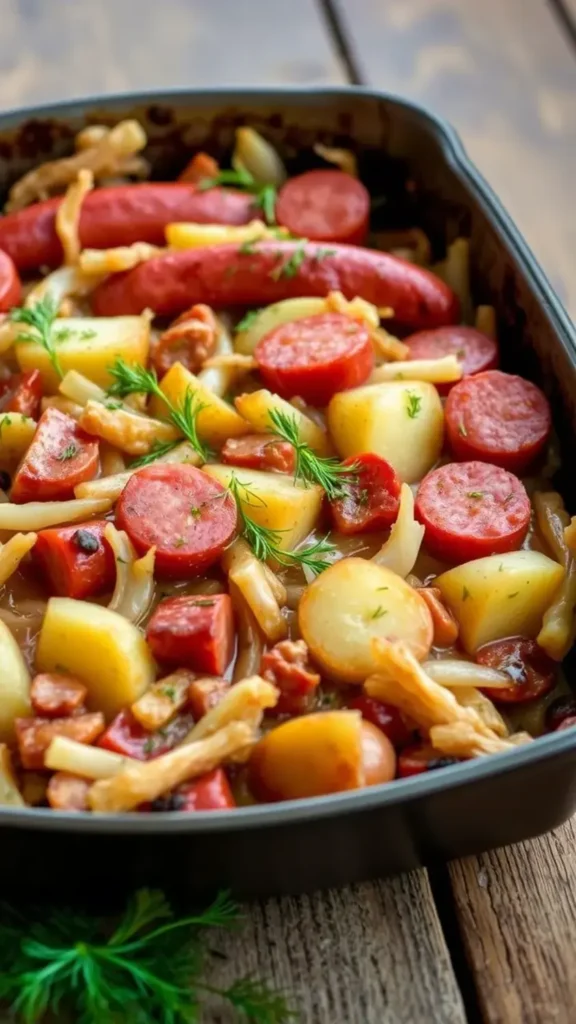Growing up, our family loved being in the kitchen. The smell of sausage and sauerkraut would fill the air. It meant it was time for our favorite Polish casserole.
This dish is a mix of tasty flavors and soft textures. It has been a big part of our meals for years. It brings us together for cozy dinners.
Thinking back, I remember the dish’s deep cultural roots. The Polish casserole, with its kielbasa sausage, is more than food. It shows the Polish people’s strength and cooking skill.
Every bite is a story of tradition. From the soft pasta to the gooey cheese, it’s a taste of history.
Key Takeaways
- Polish casserole is a beloved comfort food classic featuring savory sausage, tangy sauerkraut, and rich cheese.
- This dish is a testament to the culinary heritage and traditions of the Polish people, with roots that stretch back generations.
- The recipe can be easily adapted to accommodate different serving sizes and preferences, making it a versatile choice for family dinners and gatherings.
- The combination of tender pasta, flavorful sausage, and melted cheese creates a satisfying and comforting meal.
- Leftover casserole can be stored in the fridge or frozen for easy reheating, making it a convenient option for busy weeknights.
The Rich Heritage of Polish Comfort Food
Polish cuisine has a long and rich history. Traditional recipes have been passed down for generations. At the heart of this tradition is sausage making, which dates back to the Middle Ages.
Polish sausages, known as kielbasa, were first made to preserve meat. This ensured families could enjoy tasty proteins all year.
Origins of Polish Sausage Making
The history of Polish sausage making starts in rural communities. Farmers and butchers made these savory links. They smoked and cured the meats, adding spices and herbs for unique flavors.
These sausages became a key part of Polish cuisine. They were used in many dishes, like casseroles and stews.
Evolution of Traditional Casserole Dishes
As sausage making evolved, so did Polish casseroles. Cooks mixed preserved meats with local ingredients like potatoes and cabbage. This created hearty, one-dish meals.
Today, the kielbasa casserole is a symbol of Polish comfort food. It combines smoked sausage, sauerkraut, and creamy sauce. This dish shows the lasting appeal of Polish cuisine.
Essential Ingredients for Polish Casserole
To make a real Polish casserole, you need a few key ingredients. Kielbasa, a smoked Polish sausage, is at the center. It brings a smoky and savory taste. The dish also needs carbs like pasta or potatoes.
Sauerkraut adds a tangy flavor, balancing the dish’s richness. The sauce is creamy, often made with cream of mushroom soup or a homemade white sauce. It’s seasoned with garlic, onions, and Dijon mustard for extra flavor.
Finally, Swiss or mozzarella cheese is added. It melts into the dish, making it rich and comforting.
| Ingredient | Quantity |
|---|---|
| Kielbasa or smoked Polish sausage | 1 lb, sliced |
| Pasta or potatoes | 3 cups, cooked |
| Sauerkraut | 1 cup |
| Cream of mushroom soup or white sauce | 1 can (10.5 oz) or 2 cups |
| Dijon mustard | 2 tbsp |
| Garlic, minced | 2 cloves |
| Swiss or mozzarella cheese, shredded | 2-3 cups |
With these ingredients, you can make a delicious Polish kielbasa casserole or potato casserole. The secret is balancing flavors and textures for a satisfying dish.
Understanding Kielbasa: The Heart of Polish Casserole
Kielbasa is at the heart of any Polish casserole. It’s a sausage made from pork, beef, or veal. This sausage adds a rich, smoky flavor to these dishes.
The type of kielbasa you pick can change the taste of your casserole. It’s key to making a great dish.
Types of Kielbasa for Casseroles
Smoked kielbasa is the best choice for a Polish casserole. The smoke gives it a deeper flavor. But, you can try garlic or spicy kielbasa for a different taste.
Proper Preparation Techniques
To make your kielbasa stand out, prepare it right. Cut it into 1/4-inch thick pieces. Then, brown it in a hot skillet before adding it to the casserole.
This step locks in the flavor and adds a nice texture.
Flavor Enhancement Tips
Adding the right ingredients can make your dish even better. Try sauerkraut or mustard to balance the sausage’s richness. You can also use herbs and spices like caraway seeds or paprika.
Understanding kielbasa and how to prepare it can make your Polish casserole amazing. Get ready to enjoy the real flavors of Poland with every bite!
Creating the Perfect Creamy Sauce Base
The creamy casserole sauce is the heart of a delicious Polish casserole. You can make it from scratch or use canned soup. The goal is to get a smooth, thick sauce that covers everything well.
To make a homemade sauce, start with a roux. Melt 2 tablespoons of butter in a pan. Then, whisk in 2 tablespoons of all-purpose flour. Cook it for a minute or two, stirring constantly, until it smells good and thickens a bit.
Next, slowly add 2 1/2 cups of milk, whisking all the time to avoid lumps.
After it thickens, add 1 cup of sour cream and 2 tablespoons of Dijon mustard. Season with 1 teaspoon of garlic powder, kosher salt, and freshly ground black pepper to taste. This will give you a rich, creamy sauce perfect for baked casseroles.
If you’re short on time, use a 16-ounce can of cream of mushroom soup as a base. Mix it with sour cream, Dijon, and seasonings. This way, you can make a creamy sauce quickly.
No matter how you make it, the sauce should be thick enough to coat the ingredients well. This ensures a delicious and satisfying creamy casserole dish that everyone will love.
The Role of Sauerkraut in Polish Cuisine
Sauerkraut, the fermented cabbage delight, is a key part of Polish cuisine. It’s a main ingredient in the famous cabbage casserole. This tangy, probiotic-rich ingredient brings a unique flavor and texture to the dish.
Understanding the role of polish sauerkraut in this classic casserole is crucial. It’s essential for getting the authentic taste and texture.
Traditional Fermentation Methods
The secret to great sauerkraut is its traditional fermentation. It starts with shredding fresh cabbage and sprinkling it with salt. Then, it ferments naturally for 10 to 30 days, depending on how sour you like it.
This slow fermentation process boosts the flavor. It also adds beneficial probiotics that support a healthy gut.
Balancing Flavors with Sauerkraut
In the cabbage casserole, sauerkraut balances the rich, creamy elements and the savory polish sausage. It adds a delightful tanginess that harmonizes with the other flavors.
It’s important to drain and rinse the sauerkraut before adding it to the casserole. This lets you control how tangy and salty it is.
| Ingredient | Quantity |
|---|---|
| Sauerkraut | 3-4 cups |
| Smoked Kielbasa Sausage | 1 lb |
| Cooking Time | 2 hours 30 minutes |
| Baking Time | 30 minutes at 350°F |
| Servings | 6-10 |
Step-by-Step Assembly Process
Making the perfect polish casserole recipe is all about layering and assembly. Start by getting your cooked pasta or sliced potatoes ready. Also, brown the kielbasa and prepare the sauerkraut. Place these in a baking dish, layer by layer, for even distribution.
Then, mix up a creamy sauce to pour over the layers. This sauce will blend the flavors and textures beautifully. After spreading the sauce, top it all with your favorite cheese.
Heat your oven to 350°F (175°C). Bake the casserole for 40-50 minutes until the cheese is golden and bubbly. This step lets the flavors mix and the textures get just right.
To make it look amazing, garnish the hot polish casserole recipe with fresh herbs or sour cream. Serve it with a green salad or roasted veggies for a full meal.
| Ingredient | Percentage |
|---|---|
| Smoked Polish Sausage (Kielbasa) | 40% |
| Sauerkraut | 25% |
| Cooked Pasta or Potatoes | 20% |
| Creamy Sauce | 10% |
| Melted Cheese | 5% |
Cheese Selection and Layering Techniques
Creating the perfect Polish casserole starts with the right cheese. Swiss and mozzarella are top picks because they melt well and taste great together.
Best Cheese Combinations
Use freshly grated cheese for the best results. It melts more evenly than pre-shredded cheese. Layering cheese in stages adds flavor and texture.
Try Swiss and mozzarella, or mix in Gruyère for a unique taste. The goal is to find cheeses that melt well and boost the dish’s flavor.
Proper Melting Methods
Evenly spread the cheese on top for a gooey, golden topping. Baking at the right temperature and time is key for perfect melting.
Mastering cheese selection and layering makes your Polish casserole extra special. Enjoy every bite of this rich, melty delight.
Storage and Reheating Guidelines
Enjoying the tasty flavors of classic Polish casserole doesn’t have to stop after one meal. With the right storage and reheating, you can enjoy it for days.
For casserole storage, act fast. Put leftovers in an airtight container and refrigerate for up to 4 days. You can also freeze it for up to 3 months. The sooner you chill it, the better it stays.
When you’re ready to reheat your Polish casserole, you have choices. Cover it with foil and bake at 350°F (175°C) for 10-15 minutes. Or, reheat small portions in the microwave until hot.
Freezing your casserole? Assemble it but don’t bake until you’re ready. This keeps flavors bright and texture perfect when thawed and baked.
Follow these easy storage and reheating tips to enjoy your homemade Polish casserole for longer. Bon appétit!
Conclusion
The Polish Casserole is a true testament to the enduring power of Polish family recipes. It combines traditional flavors with modern convenience. This makes it a cherished staple in many American households.
Looking for a satisfying weeknight dinner or a special dish for a gathering? This Polish Casserole is perfect. You can customize it to your liking while keeping its Polish heritage. Every bite offers a delightful taste of Poland, from the smoked kielbasa to the tangy sauerkraut and creamy sauce.
Enjoying this Polish Casserole, you might feel like you’re in a cozy kitchen with family. It’s not just food; it’s a celebration of Polish recipes and the joy of sharing meals together. Bon appétit!
See Also:
- 7 Irresistible Reasons to Try Beef Lombardi Casserole
- Hearty Amish Country Casserole: A Family Favorite
- Best Ever Chicken and Rice Casserole Recipes You’ll Love
FAQ
What is Polish Casserole?
Polish Casserole is a tasty dish with kielbasa, sauerkraut, and creamy potatoes. It’s great for cozy dinners and special events. It combines savory sausage, tangy sauerkraut, and rich cheese.
What are the key ingredients in Polish Casserole?
Polish Casserole needs kielbasa or smoked Polish sausage, pasta or potatoes, and sauerkraut. It also has a cream-based sauce, like cream of mushroom soup, and cheese, like Swiss or mozzarella. You might also add dijon mustard, garlic, onions, and spices.
What is the history and cultural significance of kielbasa in Polish cuisine?
Kielbasa has been a Polish favorite since the Middle Ages. It’s made from pork, beef, or veal, and spices. Smoked kielbasa is best for casseroles because of its deep flavor.
How do I prepare the creamy sauce for Polish Casserole?
You can make the creamy sauce from scratch or use canned soup. For a homemade sauce, mix butter and flour, then add milk, sour cream, and seasonings. Or, use cream of mushroom soup and add dijon mustard and garlic powder.
What is the role of sauerkraut in Polish Casserole?
Sauerkraut adds tanginess and depth to the dish. It contrasts the creamy elements and complements the kielbasa. Make sure to drain and rinse the sauerkraut to control its flavor.
How should I assemble and bake the Polish Casserole?
Layer cooked pasta or potatoes, browned kielbasa, sauerkraut, and cheese in a dish. Pour the creamy sauce over the layers. Top with more cheese and bake at 350°F (175°C) for 40-50 minutes until golden.
How can I store and reheat Polish Casserole?
Store the casserole in the fridge for up to 4 days in an airtight container. Freeze it for up to 3 months. Reheat covered in foil at 350°F (175°C) until warm. Or, reheat individual portions in the microwave.
Print
Classic Polish Casserole: A Hearty Family Dinner
- Total Time: 1 hour
- Yield: 6 servings
Description
A comforting Polish casserole featuring smoked kielbasa, tangy sauerkraut, tender pasta or potatoes, and gooey cheese, all brought together in a creamy sauce. This dish is a celebration of Polish culinary heritage and is perfect for cozy family dinners or gatherings.
Ingredients
- Kielbasa or smoked Polish sausage: 1 lb, sliced
- Pasta or potatoes: 3 cups, cooked
- Sauerkraut: 1 cup
- Cream of mushroom soup or white sauce: 1 can (10.5 oz) or 2 cups
- Dijon mustard: 2 tbsp
- Garlic, minced: 2 cloves
- Swiss or mozzarella cheese, shredded: 2–3 cups
Instructions
- Preheat your oven to 350°F (175°C).
- Cook pasta or potatoes and set aside.
- Brown the kielbasa slices in a skillet and set aside.
- Drain and rinse the sauerkraut to control tanginess, then set aside.
- In a baking dish, layer cooked pasta or potatoes, browned kielbasa, and sauerkraut.
- Prepare the creamy sauce:
- Option 1: Mix cream of mushroom soup with Dijon mustard and garlic.
- Option 2: For a homemade sauce, melt 2 tbsp butter in a pan, whisk in 2 tbsp flour, and cook for 1 minute. Gradually add 2 1/2 cups milk, whisking continuously, until thickened. Stir in 1 cup sour cream, Dijon mustard, garlic powder, salt, and pepper.
- Pour the creamy sauce evenly over the layers in the baking dish.
- Top with shredded Swiss or mozzarella cheese.
- Bake uncovered for 40–50 minutes or until the cheese is golden and bubbly.
- Let the casserole rest for a few minutes before serving. Garnish with fresh herbs if desired.
Notes
- Use smoked kielbasa for a deeper flavor.
- Rinsing sauerkraut helps balance its tanginess.
- For a crispy topping, add breadcrumbs mixed with melted butter before baking.
- Serve with a green salad or roasted vegetables for a complete meal.
- Prep Time: 20 minutes
- Cook Time: 40 minutes
- Category: Main Course
- Method: Baking
- Cuisine: Polish
Nutrition
- Serving Size: 1 cup (approx.)
- Calories: 400
- Sugar: 4g
- Sodium: 950mg
- Fat: 25g
- Saturated Fat: 10g
- Unsaturated Fat: 13g
- Trans Fat: 0g
- Carbohydrates: 22g
- Fiber: 2g
- Protein: 16g
- Cholesterol: 50mg


